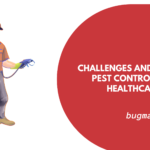
Pests can wreak havoc in any environment, but their presence in healthcare facilities poses unique challenges that demand immediate attention. Dhaka’s healthcare facilities, like hospitals and clinics, play a crucial role in maintaining public health.
Therefore, ensuring effective pest control in these facilities is of utmost importance. This article delves into the challenges faced by healthcare facilities in Dhaka concerning pest control and proposes actionable solutions to mitigate these issues.
Common Pests Encountered in Dhaka’s Healthcare Facilities
Bedbugs
Bedbugs can infest hospital beds, waiting areas, and patient rooms, causing discomfort and potential allergic reactions.
Cockroaches
Cockroaches are carriers of various pathogens and can trigger asthma and allergies in both patients and staff.
Rodents
Rodents pose a significant threat by contaminating food, spreading diseases, and causing damage to the facility’s structure.
Flies and Mosquitoes
These pests can transmit diseases like dengue and typhoid, particularly problematic in a healthcare setting.
The Challenges of Pest Infestations
Health Risks to Patients and Staff
Pests can transmit diseases, putting vulnerable patients and healthcare workers at risk.
Damage to Infrastructure and Equipment
Pests can gnaw through cables, wires, and equipment, leading to expensive repairs and replacements.
Adverse Impact on Reputation
Reports of pest infestations can tarnish a healthcare facility’s reputation, affecting patient trust and public perception.
Factors Contributing to Pest Infestations
Urban Environment
Dhaka’s urban landscape provides pests with ample hiding spots and breeding grounds.
Waste Management Issues
Improper disposal of medical and general waste can attract pests, exacerbating the infestation problem.
Inadequate Building Maintenance
Cracks, crevices, and neglected maintenance can provide entry points for pests.
Pest Control Solutions for Healthcare Facilities
Integrated Pest Management (IPM) Strategies
IPM involves using a combination of preventive measures, pest monitoring, and targeted treatments to minimize infestations.
Regular Facility Maintenance
Sealing cracks, maintaining cleanliness, and addressing moisture issues can reduce pest entry points.
Proper Waste Disposal
Adhering to strict waste disposal protocols minimizes pest attraction.
Staff Education and Training
Training healthcare staff about pest awareness and prevention enhances the facility’s overall pest control efforts.
Collaborative Efforts: Involvement of Healthcare Staff and Pest Control Professionals
Collaboration between healthcare staff and pest control experts ensures a comprehensive approach to pest management.
Overcoming Financial Constraints: Budget Allocation for Pest Control
Allocating a portion of the budget for pest control is an investment in long-term facility integrity and patient safety.
Implementing Stringent Monitoring and Surveillance Measures
Regular inspections and surveillance help detect and address pest issues in their early stages.
Case Studies: Successful Pest Control Implementation
Examining instances where healthcare facilities effectively tackled pest infestations can offer valuable insights for others.
FAQs
Are pest infestations common in healthcare facilities?
A: Yes, due to various factors, pests can become a significant issue in healthcare facilities.
How can healthcare staff contribute to pest control?
Healthcare staff can help by adhering to cleanliness standards and promptly reporting pest sightings.
What is Integrated Pest Management (IPM)?
IPM is a comprehensive approach that combines preventive measures, monitoring, and targeted treatments to manage pests.
How often should pest inspections be conducted?
Regular pest inspections should be conducted at least quarterly to detect and address issues early.
Can pest-related reputation damage be reversed?
While challenging, taking swift and effective pest control measures can gradually restore a facility’s reputation.
Conclusion
Effective pest control is a vital aspect of maintaining a safe and hygienic environment in Dhaka’s healthcare facilities.
By acknowledging the challenges posed by pests and implementing proactive strategies, healthcare institutions can ensure the well-being of patients, staff, and their reputation. Through collaborative efforts, proper maintenance, and vigilant monitoring, pest-related issues can be mitigated successfully.
